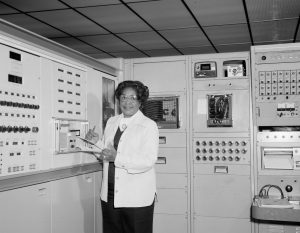Mary Winston Jackson
First NASA African American mathematician, aerospace engineer. She was featured in the movie Hidden Figures

(April 9, 1921 – February 11, 2005)
For Mary Winston Jackson, a love of science and a commitment to improving the lives of the people around her were one and the same. In the 1970s, she helped children in the science club at Hampton’s King Street Community center build their own wind tunnel and use it to conduct experiments. “We have to do something like this to get them interested in science,” she said in an article for the local newspaper. “Sometimes they are not aware of the number of black scientists, and don’t even know of the career opportunities until it is too late.”
Mary’s own path to an engineering career at the NASA Langley Research Center was far from direct. A native of Hampton, Virginia, she graduated from Hampton Institute in Virginia in 1942 with a dual degree in math and physical sciences. Upon graduation, she accepted a job as a math teacher at William Sampson Brooks High School a segregated school in Calvert County. Maryland. She was known as Miss Winston then. She did not become Mrs. Levi Jackson until 1944.
After a year of teaching, Mary returned to Virginia. There, her first job was as a receptionist at the King Street USO Club, which served the city’s black population. It would take three more career changes- as a bookkeeper in Hampton Institute’s Health Department, a stint at home following the birth of her son, Levi, and a job as an Army secretary at Fort Monroe—before Mary landed a job at the Langley Memorial Aeronautical Laboratory’s segregated West Area Computing section in 1951. There working as a computer, she reported to the group’s supervisor Dorothy Vaughan.
After two years, Mary received an offer to work for engineer Kazimierz Czarnecki in the 4-foot by 4-foot Supersonic Pressure Tunnel, a 60,000 horsepower wind tunnel capable of blasting models with winds approaching twice the speed of sound. Czarnecki offered Mary hands-on experience conducting experiments in the facility. He eventually suggested that she enter a training program that would allow her to earn a promotion from mathematician to engineer. Trainees took graduate level math and physics in after-work courses managed by University of Virginia. Because the classes were held at then-segregated Hampton High School, Mary needed special permission from the City of Hampton to join her white peers in the classroom. Mary completed the courses and earned the promotion. In 1958, Mary Jackson became the NASA’s first female African American engineer. That same year, she co-authored her first report, “Effects of Nose Angle and Mach Number on Transition on Cones at Supersonic Speeds”.
In the 1950s, Mary very well may have been the only black female aeronautical engineer in the field. For nearly two decades she enjoyed a productive engineering career, authoring or co-authoring a dozen or so research reports, most focused on the behavior of the boundary layer of air around airplanes.
Over the years, the promotions slowed, and she became frustrated at her inability to break into management-level grades. In 1979, seeing that the “glass ceiling” was the rule rather than the exception for the center’s female professionals, she made a final, dramatic career change, leaving engineering and taking a demotion to fill the open position of Langley’s Federal Women’s Program Manager. There, she worked hard to impact the hiring and promotion of NASA’s female mathematicians, engineers and scientists.
Mary retired from Langley in 1985. Among her many honors were an Apollo Group Achievement Award, and being named Langley’s Volunteer of the Year in 1976. She was a Girl Scout troop leader for more than 30 years and a member of the National Technical Association (the oldest African American technical organization in the United States). In 2019 she was awarded the Congressional Gold Medal. NASA’s headquarters in Washington, D.C. was renamed the Mary W. Jackson NASA Headquarters February 26, 2021.
A 1976 Langley Researcher profile captured Mary’s spirit and character, calling her a “gentlelady, wife and mother, humanitarian and scientist.” For Mary W. Jackson, science and service went hand in hand.
Additional Resources
Part of this Biography were taken from Margot Lee Shetterly biography, Mary W. Jackson – NASA
Potter, Sean (February 24, 2021). “NASA to Honor ‘Hidden Figure’ Mary W. Jackson During Naming Ceremony”. NASA.
Joseph, Natalie (December 10, 2019). “‘Hidden Figures’ Honored at U.S. Capitol for Congressional Gold Medal”. NASA.
“Mary Jackson Obituary (2005) – Hampton, VA – Daily Press”. Legacy.com.
